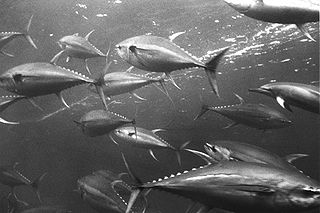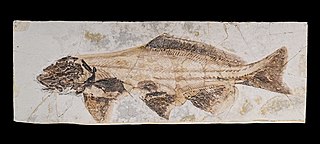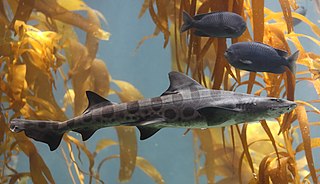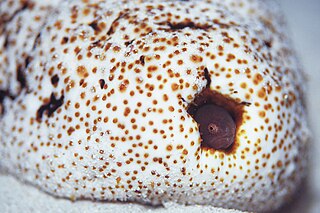
The Cyprinidae are the family of freshwater fish, collectively called cyprinids, that includes the carps, the true minnows, and their relatives. Also commonly called the "carp family", or "minnow family", Cyprinidae is the largest and most diverse fish family and the largest vertebrate animal family in general, with about 3,000 species of which only 1,270 remain extant, divided into about 370 genera. They range from about 12 mm to the 3-m Catlocarpio siamensis. The family belongs to the ostariophysian order Cypriniformes, of whose genera and species the cyprinids make up more than two-thirds. The family name is derived from the Ancient Greek kyprînos.

The Percidae are a family of ray-finned fish, part of the order Perciformes, which are found in fresh and brackish waters of the Northern Hemisphere. The majority are Nearctic, but there are also Palearctic species. The family contains more than 200 species in 11 genera. The perches, and their relatives are in this family; well-known species include the walleye, sauger, ruffe, and three species of perch. However, small fish known as darters are also a part of this family.

Clupeiformes is the order of ray-finned fish that includes the herring family, Clupeidae, and the anchovy family, Engraulidae. The group includes many of the most important forage and food fish.

Clupeidae is a family of ray-finned fishes, comprising, for instance, the herrings, shads, sardines, hilsa, and menhadens. The clupeoids include many of the most important food fishes in the world, and are also commonly caught for production of fish oil and fish meal. Many members of the family have a body protected with shiny cycloid scales, a single dorsal fin, and a fusiform body for quick, evasive swimming and pursuit of prey composed of small planktonic animals. Due to their small size and position in the lower trophic level of many marine food webs, the levels of methylmercury they bioaccumulate are very low, reducing the risk of mercury poisoning when consumed.

The mackerel, tuna, and bonito family, Scombridae, includes many of the most important and familiar food fishes. The family consists of 51 species in 15 genera and two subfamilies. All species are in the subfamily Scombrinae, except the butterfly kingfish, which is the sole member of subfamily Gasterochismatinae.

Characidae, the characids or characins is a family of freshwater subtropical and tropical fish, belonging to the order Characiformes. The name "characins" is the historical one, but scientists today tend to prefer "characids" to reflect their status as a by and large monophyletic group at family rank. To arrive there, this family has undergone much systematic and taxonomic change. Among those fishes that remain in the Characidae for the time being are the tetras, comprising the very similar genera Hemigrammus and Hyphessobrycon, as well as a few related forms such as the cave and neon tetras. Fish of this family are important as food and also include popular aquarium fish species.

Acipenseriformes is an order of basal ray-finned fishes that includes the sturgeons and paddlefishes, as well as some extinct families.

Groupers are fish of any of a number of genera in the subfamily Epinephelinae of the family Serranidae, in the order Perciformes.

Gouramis, or gouramies, are a group of freshwater anabantiform fishes that comprise the family Osphronemidae. The fish are native to Asia—from Pakistan and India to Southeast Asia and northeasterly towards Korea. The name "gourami", of Indonesian origin, is also used for fish of the families Helostomatidae and Anabantidae.

The Congridae are the family of conger and garden eels. Congers are valuable and often large food fishes, while garden eels live in colonies, all protruding from the sea floor after the manner of plants in a garden. The family includes over 180 species in 32 genera.

The Carangidae are a family of ray-finned fish which includes the jacks, pompanos, jack mackerels, runners, and scads. It is the largest of the six families included within the order Carangiformes. Some authorities classify it as the only family within that order but molecular and anatomical studies indicate that there is a close relationship between this family and the five former Perciform families which make up the Carangiformes.
Pearlfish are marine fish in the ray-finned fish family Carapidae. Pearlfishes inhabit the tropical waters of the Atlantic, Indian, and Pacific Oceans at depths to 2,000 m (6,600 ft), along oceanic shelves and slopes. They are slender, elongated fish with no scales, translucent bodies, and dorsal fin rays which are shorter than their anal fin rays. Adults of most species live symbiotically inside various invertebrate hosts, and some live parasitically inside sea cucumbers. The larvae are free living.

Houndsharks, the Triakidae, are a family of ground sharks, consisting of about 40 species in nine genera. In some classifications, the family is split into two subfamilies, with Mustelus, Scylliogaleus, and Triakis in the subfamily Triakinae, and the remaining genera in the subfamily Galeorhininae.
Barbinae are a subfamily of fish included in the family Cyprinidae. The taxonomy for this group has not been entirely worked out as some genera historically considered within it are still considered incertae sedis with respect to being a member of the family, and may be included here, while others may be moved to other subfamilies.
The star pearlfish, Carapus mourlani, is a species of slender, ray-finned fish in the family Carapidae. It normally lives inside a starfish or a sea cucumber.

The pinhead pearlfish, Encheliophis boraborensis, is a species of slender, ray-finned fish in the family Carapidae found in the tropical Indo-Pacific Ocean; it normally lives inside the body cavity of a sea cucumber such as the pineapple sea cucumber or the leopard sea cucumber.

Caprodon is a small genus of fish belonging to the subfamily Anthiinae. It contains three species.

The Anabantiformes are an order of freshwater ray-finned fish with two suborders, five families and having at least 207 species. In addition, some authorities expand the order to include the suborder Nandoidei, which includes three families - the Nandidae, Badidae and Pristolepididae - that appear to be closely related to the Anabantiformes. The order, and these three related families, are part of a monophyletic clade which is a sister clade to the Ovalentaria, the other orders in the clade being Synbranchiformes, Carangiformes, Istiophoriformes and Pleuronectiformes. This clade is sometimes referred to as the Carangaria but is left unnamed and unranked in Fishes of the World. This group of fish are found in Asia and Africa, with some species introduced in United States of America.

Scombriformes is an order of bony fish containing nine families which were classified under the suborders Scombroidei and Stromateoidei, of the wider grouping known as Perciformes, Nelson (2016) recognised the order but subsequent workers have suggested that Scombriformes forms part of the larger Pelagiaria clade.

The Leuciscidae, commonly known as true minnows, are a large family of the freshwater fish order Cypriniformes.
















